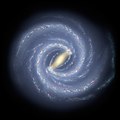| Draco Dwarf | |
|---|---|
 Field image of the Draco dwarf spheroidal galaxy, by the Digitized Sky Survey | |
| Observation data (J2000 epoch) | |
| Constellation | Draco |
| Right ascension | 17h 20m 12.4s [1] |
| Declination | +57° 54′ 55″ [1] |
| Redshift | −292 ± 21 km/s [1] |
| Distance | 260 ± 30 kly (75.4 kpc) [2] [3] [4] |
| Apparent magnitude (V) | 10.9 [1] |
| Characteristics | |
| Type | E pec [1] |
| Mass | 1.2×108 [4] [e] M☉ |
| Apparent size (V) | 35.5′ × 24.5′ [1] |
| Notable features | Highest known dark matter concentrated object |
| Other designations | |
| Draco Dwarf Spheroidal, [1] Draco dSph, [5] UGC 10822, [1] PGC 60095, [1] DDO 208, [1] | |
The Draco Dwarf is a spheroidal galaxy which was discovered by Albert George Wilson of Lowell Observatory in 1954 on photographic plates of the National Geographic Society's Palomar Observatory Sky Survey (POSS). [6] It is part of the Local Group and a satellite galaxy of the Milky Way galaxy. The Draco Dwarf is situated in the direction of the Draco Constellation at 34.6° [7] above the galactic plane.
